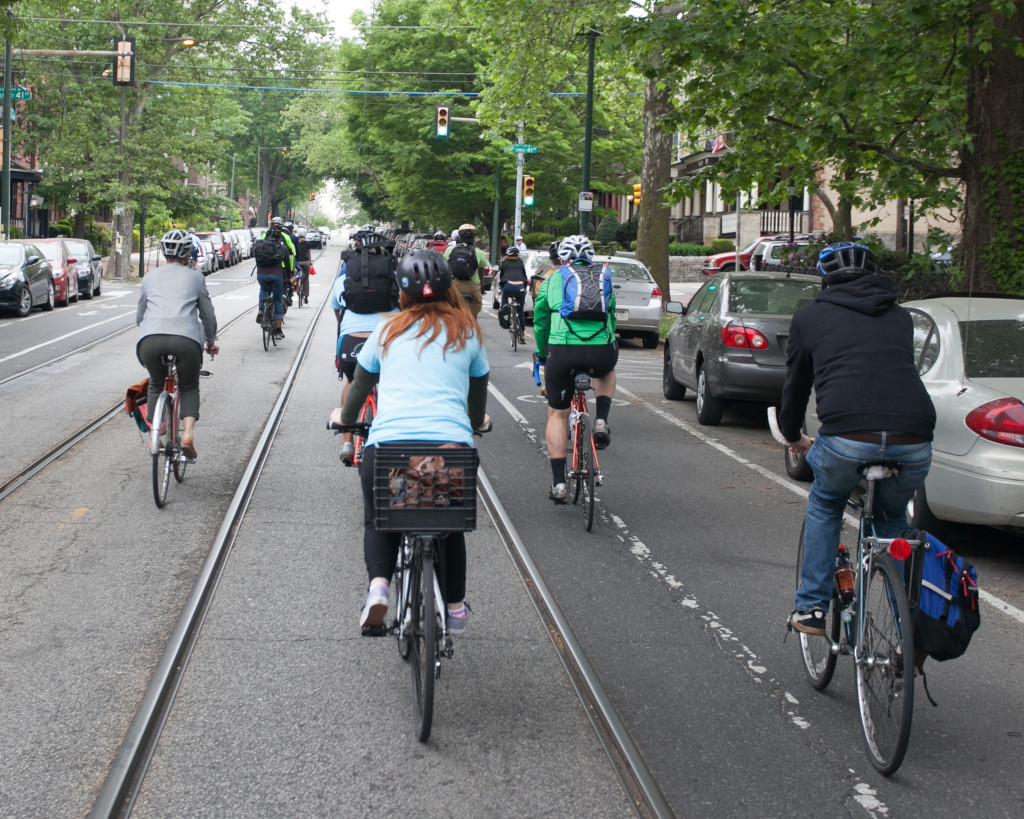
Philadelphia bicyclists commute on Bike To Work Day 2015
The U.S. Census Bureau released its 2014 American Community Survey this morning detailing, in part, U.S. cities’ bike commuting populations—and for Philadelphia, there’s both good news and bad.
First, the details: The American Community Survey is a yearly survey done by the U.S. Census. The Survey is designed to help local officials, community leaders and businesses understand changes in their communities. One of the categories the Survey looks at is commuting to work, and the League of American Bicyclists put together the data as it pertains to bicycling.
On the whole, 0.62 percent of U.S. commuted to work by bicycle in 2014 were made by bicycle—a 0.5 percent increase from 2013 and a 62 percent increase since 2000.
For our part, Philadelphia saw a decrease in its mode share between 2013 and 2014. We’ve gone from 2.3 percent of citizens calling themselves bicycle commuters to 1.9 percent.Meaning of the city’s 688,496 residents who commute to work (according to the Survey), 12,282 are regular bicycle commuters. Pittsburgh is now the most-biked city in Pennsylvania, by percentage.
Mode-share-wise, we’re behind some of the very well-known biked cities like Portland, Oregon (7 percent call themselves bike commuters) and Minneapolis, MN (4.65 percent are bike commuters), but we remain the most-biked big city in the United States, i.e., cities with populations over 1 million people. Philadelphia also ranks 10th for all biked cities in the United States.
That said, Chicago, one of the five most-populous cities in the United States, is quickly catching up to Philadelphia. Chicago’s mode-share of bicyclists rose from 1.4 percent in 2013 to 1.7 percent in 2014.
And why is Chicago going up while Philly’s going down? One theory can be traced back to our Safer Streets report, released in December 2014 . In so many words: If you build it, they will bike.
Philadelphia was well-ahead of most big U.S. cities as far as infrastructure went between the mid-90s and mid-2000s. But between 2008 and 2013, other cities started catching up.
Chicago added an annual average of 12.3 miles of bike lanes between 2008 and 2013; Philly added just six. As for planned lanes in 2014, Chicago topped all big cities, at 20, while Philadelphia had planned just 8.4. Chicago has also dedicated a higher percentage of their budget to their streets than Philadelphia (1.7 percent to 0.7 percent) and more dollars per capita to streets than Philadelphia ($20 to $16). Add to that the fact that planned bike lanes can be blocked by City Council members and, well, it’s easy to see why other cities are catching up.
Studies regularly show that more people bike when they feel safer biking. And more bike infrastructure makes people feel safer. And more people biking actually does make cycling safer for everyone. Chicago (and most cities) also have begun installing dedicated lanes of protected bike lanes on city streets; Philadelphia has not. That city has also planned more lanes than we have for the future.

We have dedicated protected bike lanes in Philadelphia?
Yes. About 100 yards along Delaware Avenue by Yards Brewery, that dumps you into the Sugarhouse parking lot.
Doesn’t matter. Philadelphia will always be the most bikeable city in the U.S. and have the largest number of bikers. Other cities wish they could be 1% as good as Philly. Also our bike sharing system is much more successful than the half-assed attempts NYC and Chicago could come up with.
We’re losing ground because we have hit a wall in terms of dedicating infrastructure to bicycles. In fact, we’re regressing in several cases. Bike lane paint has worn down to the point where you can’t even see it’s a bike lane anymore; there is little to NO enforcement when it comes to people parking in bike lanes; physical, protective infrastructure is not being implemented in places where it absolutely should (think Pine and Spruce…no reason there shouldn’t be concrete separating lanes); dangerous intersections like Washington and 9th are stymied by a weak/underfunded Streets Department and NIMBY groups that represent the monopoly of driving/parking.
Leadership in other cities like Boston are stepping up and pushing change, even if it is initially met with scrutiny. We are at a stalemate, and it will only be broken if leadership and funding step up and make a real commitment, something I’m not expecting with Kenney entering as mayor….given that he’s already made statements like “leave South Philly as-is”; meaning parked cars on sidewalks, bike lanes, medians, crosswalks, etc.
The problem is That Philly’s bikeability is entirely the result of “good bones”. Our tight grid and narrow streets naturally calm traffic. Spruce, Pine, 10th, and 13th are a joke, never enforced and constantly violated. Beyond that, most bike lanes in Philly are just sharrows and shoulders.
I must caution you on the use of one-year estimates of the American Community Survey. It is much more reliable to use five-year estimates. Those numbers have a larger sample size and a smaller margin of error. Wait until December when the new five-year estimates are released, and compare them to last year’s five-year estimates. It will be a much more accurate representation of long-term changes in trends.